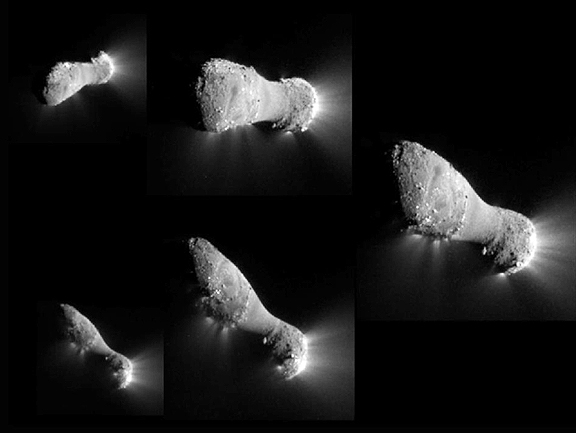Scientists say initial images from the flyby provide new information about the comet's volume and material spewing from its surface. "Early observations of the comet show that, for the first time, we may be able to connect activity to individual features on the nucleus," said EPOXI Principal Investigator Michael A'Hearn of the University of Maryland, College Park. "We certainly have our hands full. The images are full of great cometary data, and that's what we hoped for."
EPOXI is an extended mission that uses the already in-flight Deep Impact spacecraft. Its encounter phase with Hartley 2 began at 1:00 p.m. PDT (4 p.m. EDT) on Nov. 3, when the spacecraft began to point its two imagers at the comet's nucleus. Imaging of the nucleus began one hour later. Images from the EPOXI mission reveal comet Hartley 2 to have 100 times less volume than comet Tempel 1, the first target of Deep Impact. More revelations about Hartley 2 are expected as analysis continues. Initial estimates indicate the spacecraft was about 700 kilometers (435 miles) from the comet at the closest-approach point. That's almost the exact distance that was calculated by engineers in advance of the flyby.

This image montage shows comet Hartley 2 as NASA's EPOXI mission approached and flew under the comet. The images progress in time clockwise, starting at the top left. The image was taken by EPOXI's Medium-Resolution Instrument on Nov. 4, 2010. The sun is to the right. Image credit: NASA/JPL-Caltech/UMD
"It is a testament to our team's skill that we nailed the flyby distance to a comet that likes to move around the sky so much," said Tim Larson, EPOXI project manager at NASA's Jet Propulsion Laboratory in Pasadena, Calif. "While it's great to see the images coming down, there is still work to be done. We have another three weeks of imaging during our outbound journey." The name EPOXI is a combination of the names for the two extended mission components: the Extrasolar Planet Observations and Characterization (EPOCh), and the flyby of comet Hartley 2, called the Deep Impact Extended Investigation (DIXI). The spacecraft has retained the name "Deep Impact." In 2005, Deep Impact successfully released an impactor into the path of comet Tempel 1. NASA's Jet Propulsion Laboratory, a division of the California Institute of Technology, manages the EPOXI mission for NASA's Science Mission Directorate. The spacecraft was built for NASA by Ball Aerospace & Technologies Corp., in Boulder, Colo.

